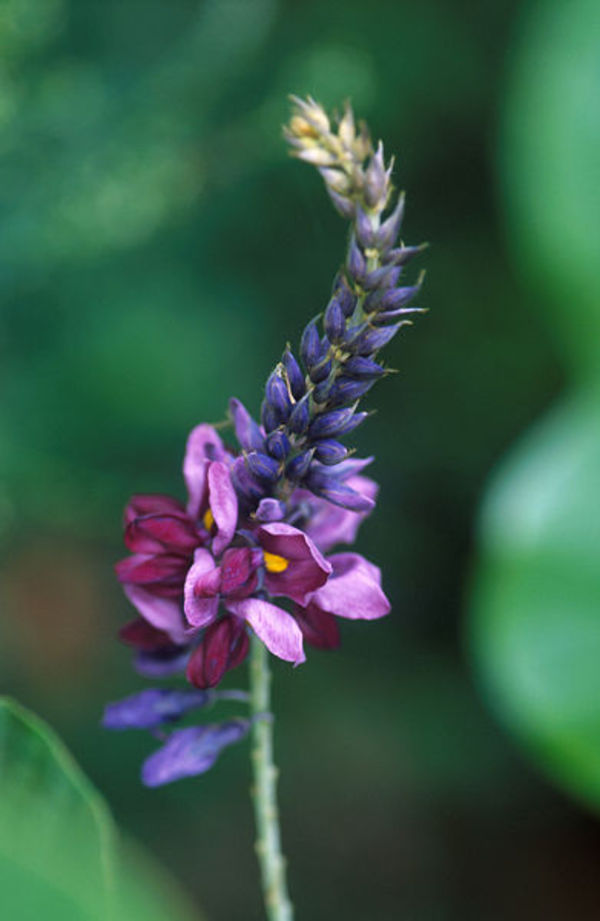
Common Name: Kudzu | Scientific Name: Pueraria Lobata

Family Name: Leguminosae
Introduction
Kudzu is one crazy plant. It can grow up and cover a 200 foot tall tree in one season. I would say its an aggressive grower but thats not strong enough language. Clearly the plant contains some vitality compounds and, according to the Japanese, some very health building comoounds as well.
Resources
Fact Sheet
Fact Sheet
Part Used: Starch from root
Principal Use: Building tonic for convalescence, debility, run down states, heart tonic
Principle Action: Tonic
History and Traditional Uses of Kudzu
Kudzu is a perennial vine that can be found growing wild throughout the Japanese countryside. It has cordate leaves and bears bright purple spike flowers in summer. It is very vigorous plant, so vigorous that it can twine over a tree and kill it. Kudzu is a naturalized plant in south-eastern parts of the United States, having been introduced to reduce soil erosion. It escaped cultivation and is now growing over forests in America, literally.
Kudzu is used for a diverse array of purposes in Japan and is deeply imbedded in Japanese culture. In the old days, before the age of artificial materials, Kudzu vines were used to weave baskets, ropes and cloth. Its leaves’ were a favorite fodder for horses.
However, kudzu roots are the part used for food and medicine. The roots are rich in starch, 10-15% by weight. This starch is extracted by various processes developed long ago. Today, the Japanese confection industry is the largest consumer of the starch. They use it to make the exquisite traditional confections of Japanese cuisine.
In the ancient literature, Kudzu starch is described as being slightly sweet and lacking toxicity. In traditional medicine the starch is seen as being antiemetic, febrifuge, antidotal, thirst relieving, and diaphoretic. It is used to treat alcoholism, colds, diarrhea, dysentery, enteritis, fever, measles, sweating, thirst, bug bite, chickenpox, snakebite, typhoid, skin rashes and more. Simply put, Kudzu starch is seen as a building tonic which makes the body healthier and better able to resist disease-an ideal medicine to help a person recover from illness.
Science of Kudzu
Chemical Constituents
Flavonoids(1.8-12%): daizein, puerarin, methylpuerarin, 4′,6″-di-O- acetylpuerarin, genistein, formononetin, miroestrol, daizin, xylopueratin, 7,4′-diglucoside, 3-hydroxylpuerarin, puerarin. Glicoside: 4-O-D-glucoside, 8-C-apiosyl-glucosides, pueroside A, B. Pueranol. Triterpenoids: sophoradiol, soyasapogenols A, B, cantoniensistriol. Alkaloid: kassein. Saccharides: starch (10-15%); D-mantol, D-(±)pinitol. Saponins: kudzusapogenol A, B, C. 6,7-dimethoxycoumarins, 5-methylhydrantoin. β -sitosterol.
Health Builder
Kudzu is rich in starch and steroids which seem to act as stimulants to health and vitality. Indeed, it contains compounds similar to those found in world reknown tonics such as ginseng, salap, and oats. Research indicates the starch is a nutritive tonic of great strength.
General
Research has shown the isoflavonoids of Kudzu have many beneficial effects on the heart. They were observed to be hypotensive in animals, to decrease the severity of a myocardial infarction, antagonize arrhythmia, and prevent ventricular fibrillation.
Indices of heart function improved after subjects took the extract of flavonoids. The effects of the isoflavonoids may be due to a direct relaxation of coronary vessels.
Isoflavonoid glycosides are reported to have an hypotensive effect found excellent in clinical practice.
Clinical studies using preparations of Kudzu have shown to be excellent in patients suffering from angina pectoris. They experienced excellent improvement- this based on ECG readings.
A clinical study in patients with hypertension and angina pectoris showed that puerarin applied intravenously decreased blood catecholamine levels, blood pressure, and heart rate.
Experiments were conducted to determine the effect preparation of herb might help neck stiffness and neck pain resulting from hypertension. Decoctions were shown to cause the subjective symptoms to disappear in about 33% of subjects and significantly improve in 58%. While there was also improvement in related symptoms such as headaches and dizziness, there was no significant effect on the blood pressure itself.
Daidzein, daidzin, and puerarin have been reported to relieve headaches and other symptoms associated with hypertension.
The best and easiest way to use Kudzu starch is to make a hot drink with it. You just put two teaspoons of Kudzu starch and a tablespoon of sugar in a cup, add a tablespoon of cold water, then mix it well. Then pour a glass of hot water, little by little, to the mixture to create a smooth drink. Some add a touch of grated raw ginger or ginger powder. This beverage has nice flavor, tastes good, and is an excellent health food. It is a traditional food for the debilitated, because it gives quality carbohydrates which are easily absorbed by the body.
As for heart health, it can be used as a daily tonic for those experiencing heart problems. Regular use is the key to this remedy improving cardiovascular function. A hot cup of kudzu starch in the morning works wonders for those experiencing heart problems.
Bibliography
• Medicinal Plants of China, p339, 1985
• Kun-Ying Yen, The Illustrated Chinese Materia Medica, SMC Publishing INC., p58, 1992
• W. Tang, G. Eisenbrand, Chinese Drugs of Plant Origin, Springer Verlag, p799-802
• Kee Chang Huang, The Pharmacology of Chinese Herbs, CRC Press, p99-101, 1999
• Kazyuo Izawa, Color Encyclopedia of Medicinal Plants, Shufunotomosha, p327, 1998
• Hyoue Tsugawa, Thomas W. Sasek, Satoshi Fujii (1988) Kudzu starch, Shokuhin-kogyou 31(12)
• Tsuneo Nanba (1993) Encyclopedia of Japanese-Chinese medicine Hoiku-sha
• Dan Bensky and Andrew Gamble, Chinese Herbal Medicine Materia Medica, Eastland Press, p66-67 , 1986
Disclaimer: The author makes no guarantees as to the the curative effect of any herb or tonic on this website, and no visitor should attempt to use any of the information herein provided as treatment for any illness, weakness, or disease without first consulting a physician or health care provider. Pregnant women should always consult first with a health care professional before taking any treatment.
